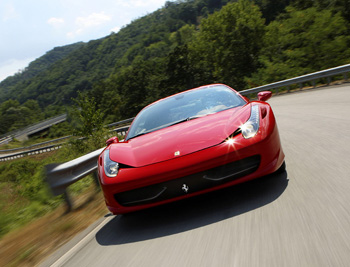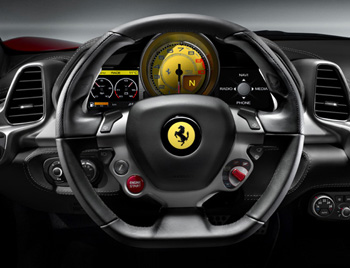
 |
|
In the run-up its unveiling in Frankfurt
Ferrari has released new pictures of the 458
Italia as well as detailing the steering
wheel and instrument binnacle which are step
forward in the concept of the ergonomic
interface between driver and car. |
|
 |
|
|
|
In
the run-up its the official unveiling at the
Frankfurt Motor Show on the 15th of September
Ferrari has released pictures of the 458 Italia
on the road as well as detailing the steering
wheel and instrument binnacle which represent a
significant step forward in the concept of the
ergonomic interface between driver and car.
In fact the main
commands are now grouped on the steering wheel, the
secondary commands are handily set in two satellite pods
either side of the dash and there are now comprehensive
instrument displays on the panel ahead of the driver. These
solutions represent an important safety aspect, enabling the
driver to concentrate fully on driving. Similarly this
layout ensures maximum control of the car in high
performance driving, an uncompromising approach that derives
directly from Ferrari’s F1 experience.
Working closely
with the Ferrari Styling Centre, the engineers have thus
reinterpreted the positioning of the major commands to
provide a truly driver-oriented cockpit. All steering-column
mounted stalks have been eliminated, with the indicators,
full beam, flash and windscreen wiper functions now being
activated by buttons on the steering wheel boss. The button
to select the shock absorber setting is now positioned next
to the ‘Engine start’ button where it falls readily to hand.
Behind the wheel are a number of secondary functions, such
as the stereo, while the gearbox paddles are now longer
making shifts even easier from any steering angle.
The right-hand
satellite pod on the dash incorporates controls for the
infotainment, the Bluetooth connection, sat-nav, digital
speedo and rear parking camera. Clustered on the left-hand
satellite pod instead are the optional cruise control,
buttons for choosing the video setting of the left-hand dash
TFT screen and the on-board computer interface. The latter
controls the trip computer, the Vehicle Dynamic Assistance
and the display of the car’s set-up.
The Vehicle
Dynamic Assistance monitors the operating parameters of the
most important areas of the car - engine/gearbox, tyres and
brakes. The VDA is enabled in the following manettino
settings – Race, CT off and CST off – and provides visual
confirmation of the status of each component based on an
algorithm from parameters reading lateral and longitudinal
acceleration, revs and speed. This enables the driver to
assess the ideal operating conditions for the car. There are
three status settings: WARM-UP (operating temperature too
low), GO (ideal operating conditions) and OVER (one or more
components are no longer at their optimum level and need
cooling).
|